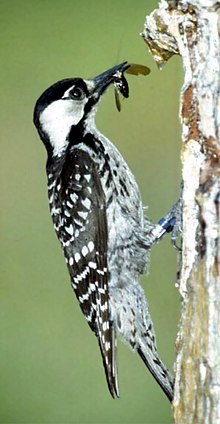Red-cockaded Woodpecker
| Red-cockaded woodpecker | |
|---|---|
 |
|
| Female red-cockaded woodpecker | |
| Scientific classification | |
| Kingdom: | Animalia |
| Phylum: | Chordata |
| Class: | Aves |
| Order: | Piciformes |
| Family: | Picidae |
| Genus: | Leuconotopicus |
| Species: | L. borealis |
| Binomial name | |
|
Leuconotopicus borealis Vieillot, 1809 |
|
| Synonyms | |
|
Picoides borealis Vieillot, 1809 |
|
Picoides borealis Vieillot, 1809
The red-cockaded woodpecker (Leuconotopicus borealis) is a woodpecker found in southeastern North America.
The red-cockaded woodpecker is small to mid-sized species, being intermediate in size between North America's two most widespread woodpeckers (the downy and hairy woodpeckers). This species measures 18–23 cm (7.1–9.1 in) in length, spans 34–41 cm (13–16 in) across the wings and weighs 40–56 g (1.4–2.0 oz). Among the standard measurements, the wing chord is 9.5–12.6 cm (3.7–5.0 in), the tail is 7–8.2 cm (2.8–3.2 in), the bill is 1.9–2.3 cm (0.75–0.91 in) and the tarsus is 1.8–2.2 cm (0.71–0.87 in). Its back is barred with black and white horizontal stripes. The red-cockaded woodpecker's most distinguishing feature is a black cap and nape that encircle large white cheek patches. Rarely visible, except perhaps during the breeding season and periods of territorial defense, the male has a small red streak on each side of its black cap called a cockade, hence its name. The species is listed as Near Threatened by the IUCN.
The red-cockaded woodpecker feeds primarily on ants, beetles, cockroaches, caterpillars, wood-boring insects, and spiders, and occasionally fruit and berries.
Red-cockaded woodpeckers are a territorial, nonmigratory, cooperative breeding species, frequently having the same mate for several years.The nesting season runs from April to June. The breeding female lays three to four eggs in the breeding male's roost cavity. Group members incubate the small white eggs for 10–13 days. Once hatched, the nestlings remain in the nest cavity for about 26–29 days. Upon fledging, the young often remain with the parents, forming groups of up to nine or more members, but more typically three to four members. There is only one pair of breeding birds within each group, and they normally only raise a single brood each year. The other group members, called helpers, usually males from the previous breeding season, help incubate the eggs and raise the young. Juvenile females generally leave the group before the next breeding season, in search of solitary male groups. The main predators of red-cockaded nests are rat snakes, although corn snakes also represent a threat.
...
Wikipedia

